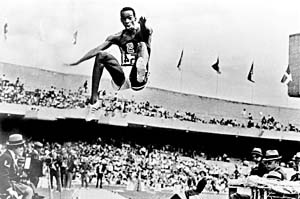
|
 |
 |
 News Around the Republic of Mexico | June 2008 News Around the Republic of Mexico | June 2008  
Olympic Tales to Cherish From Mexico, 1968
 Daily Telegraph Daily Telegraph
go to original


| | Bob Beamon: 8.90 metres (29 ft 2½ in) | | |
The Mexico City Games of 1968 arrived in a troubled summer. This was the year of the Tet Offensive in Vietnam, and the assassination of Robert Kennedy. Students were rioting and demonstrating all over the world, including in Mexico, where they felt the bureaucratic government had betrayed the principles of the Mexican Revolution.

Less than a month before the start of the Olympics, the tensions spilled over into bloodshed. An estimated 5,000 students and working people gathered in the Plaza of Three Cultures, chanting slogans such as “We don’t want Olympic Games! We want revolution!”

Gunfire broke out from the police and soldiers surrounding the square. Though the Mexican government put the death toll at 35, one English newspaper reckoned it was 267, including many women and children. As ever, the IOC tried to sidestep the political backlash. The Mexicans did, in fact, keep their side of the bargain, and the only political demonstrations came from the athletes themselves. Two black American sprinters, Tommie Smith and John Carlos, gave a ‘Black Power’ salute on the podium.

The ‘black power’ salute

Tommie Smith won the 200 metres sprint with an astonishing world-record run of 19.83 seconds but the race itself was overshadowed by the ‘Black Power’ salute that Smith went on to perform during the medal ceremony, along with bronze medallist John Carlos. Both Americans were sent home in disgrace.

Beamon’s giant leap

A year before Neil Armstrong’s “giant leap for mankind” when he stepped on to the moon’s surface, two jumpers at the Mexico City Olympics had giant leaps of their own.

One was Dick Fosbury and his revolutionary high jump technique. The other was Bob Beamon, whose winning distance in the long jump set perhaps the most extraordinary world record of all: 8.90 metres (29 ft 2½ in).

The fosbury flop

Dick Fosbury captivated the Mexico City audience with his revolutionary high-jump technique — the Fosbury Flop — which soon became the dominant style across the world.

The American cleared every height through 7ft 3¼in without a miss and then achieved an Olympic record of 7ft 4¼in to win the gold medal.

African breakthrough

It was a breakthrough Games for African runners — none more so than Kip Keino. The Kenyan dropped out of the 10,000 metres with stomach cramps. Four days later, he won the silver in the 5,000m. And then came back to win the gold in the 1500m.

Mexico’s record spree

The thin air of Mexico City produced a bunch of world records in the explosive events. In the 400 metres hurdles, Britain’s David Hemery shocked his rivals and broke the world record with his 48.12 seconds. Another Briton, John Sherwood, came through in the outside lane to claim bronze. | 
 | |
 |



